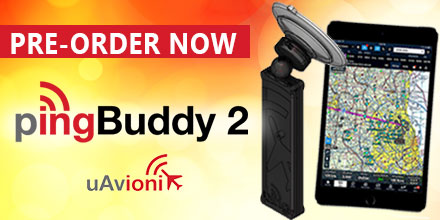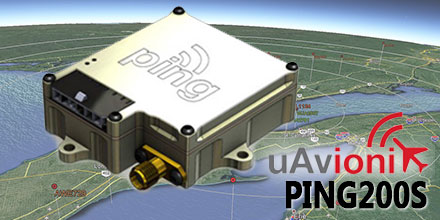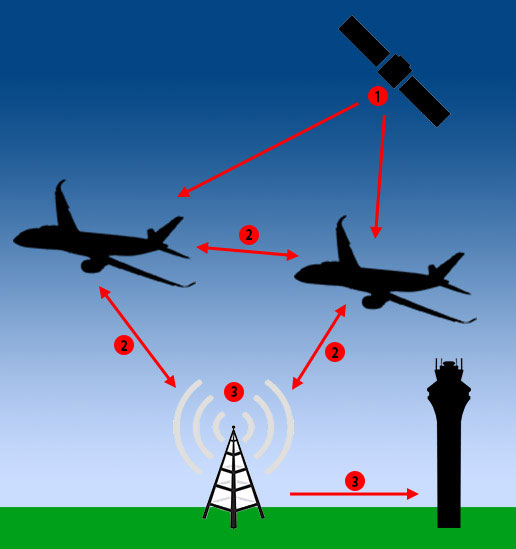08Feb
PingBuddy 2 now available for pre-order at Unmanned Systems Source
 February 8, 2017 – Unmanned Systems Source is pleased to announce that the PingBuddy 2 from uAionix is now available for pre-order.
Units are expected to ship at the end of March 2017.
Thanks to its small form-factor and inexpensive price, the original PingBuddy ADS-B receiver was a popular choice with prosumers and hobbyists, alike.
uAvionix continues its path of innovation by offering a number of improvements to this popular item.
February 8, 2017 – Unmanned Systems Source is pleased to announce that the PingBuddy 2 from uAionix is now available for pre-order.
Units are expected to ship at the end of March 2017.
Thanks to its small form-factor and inexpensive price, the original PingBuddy ADS-B receiver was a popular choice with prosumers and hobbyists, alike.
uAvionix continues its path of innovation by offering a number of improvements to this popular item.
PingBuddy 2 improvements
uAvionix describes the pingBuddy 2 as the world’s smallest and lightest Wi-Fi ADS-B receiver. It utilizes the GPS in Android and iOS devices. For phones not equipped with GPS, an external Bluetooth or GPS dongle is needed. Improvements include:- Integrated gimbal suction cup mounting system
- Improved sensitivity
- Dual antennas optimized for each ADS-B frequency
- Redesigned USB flash drive sized package
- Same low price
Additional features include
The pingBuddy 2 is a dual band (978MHz/1090MHz) ADS-B receiver with integrated Wi-Fi. It receives subscription-free in-flight weather (FIS-B) directly from FAA ground stations. FIS-B includes:- NEXRAD radar
- METARs
- TAFs
- AIRMETs
- SIGMETs
- Winds and temps aloft
- PIREPs
- NOTAMs
- TRFs

 January 30, 2017 - uAvionix Corporation based in Palo Alto, California continues to innovate within the ADS-B transceiver market.
Today, uAvionix announced the development and test of a dime-sized transceiver weighing less than 1 gram.
UAvionix worked under a Collaborative Research and Development Agreement with the FAA and other partners to test this prototype.
January 30, 2017 - uAvionix Corporation based in Palo Alto, California continues to innovate within the ADS-B transceiver market.
Today, uAvionix announced the development and test of a dime-sized transceiver weighing less than 1 gram.
UAvionix worked under a Collaborative Research and Development Agreement with the FAA and other partners to test this prototype.
 January 6, 2017 – uAvionix continues to roll-out innovative products within the Automatic Dependent Surveillance-Broadcast (ADS-B) arena.
Their latest addition? The Ping200S Mode S Transponder, which just received FCC approval.
The Ping200S provides a unique combination of small size, low power and high visibility. All these factors make it an ideal choice for drones and other beyond line of sight UAV operations.
“We are excited to offer Ping200S to the market,” said Paul Beard, CEO of uAvionix. “Until now, operators requiring a transponder had to choose between unlicensed devices or heavier, power-hungry legacy solutions.”
January 6, 2017 – uAvionix continues to roll-out innovative products within the Automatic Dependent Surveillance-Broadcast (ADS-B) arena.
Their latest addition? The Ping200S Mode S Transponder, which just received FCC approval.
The Ping200S provides a unique combination of small size, low power and high visibility. All these factors make it an ideal choice for drones and other beyond line of sight UAV operations.
“We are excited to offer Ping200S to the market,” said Paul Beard, CEO of uAvionix. “Until now, operators requiring a transponder had to choose between unlicensed devices or heavier, power-hungry legacy solutions.”
 What exactly is ADS-B and do I need it?
What exactly is ADS-B and do I need it? 1. GPS satellites provide location information to ADS-B equipped aircraft.
2. ADS-B equipped aircraft transmit altitude, speed and velocity information to other ADS-B equipped aircraft and ADS-B ground stations.
3. ADS-B ground receive stations provide aircraft location back to other aircraft, as well as air traffic control centers.
"ADS-B In" systems can be installed on any aircraft to display location information of other aircraft with ADS-B Out transmitters.
Aircraft also transmit their location directly to other “ADS-B In” equipped aircraft within their transmit area. Thus, forming a long-range mesh network that shares real-time position information.
For pilots flying with Visual Flight Rules cockpit-based ADS-B receiver displays provide earlier warning of aircraft in their flight area. This helps improve safety during inclement weather conditions.
1. GPS satellites provide location information to ADS-B equipped aircraft.
2. ADS-B equipped aircraft transmit altitude, speed and velocity information to other ADS-B equipped aircraft and ADS-B ground stations.
3. ADS-B ground receive stations provide aircraft location back to other aircraft, as well as air traffic control centers.
"ADS-B In" systems can be installed on any aircraft to display location information of other aircraft with ADS-B Out transmitters.
Aircraft also transmit their location directly to other “ADS-B In” equipped aircraft within their transmit area. Thus, forming a long-range mesh network that shares real-time position information.
For pilots flying with Visual Flight Rules cockpit-based ADS-B receiver displays provide earlier warning of aircraft in their flight area. This helps improve safety during inclement weather conditions.
